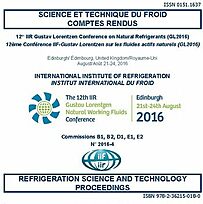
Document IIF
Évaluation des performances d'un système "booster" au R744 pour le refroidissement, le chauffage et la production d'eau chaude sanitaire dans un supermarché.
Performance evaluation of a R744 booster system for supermarket refrigeration, heating and DHW.
Numéro : pap. 1022
Auteurs : POLZOT A., GULLO P., D'AGARO P.
Résumé
Carbon dioxide is an eco-friendly refrigerant which is non-flammable and non-toxic. Due to its low critical temperature, transcritical operations in CO2 refrigeration systems can commonly take place. In these conditions, favourable thermo-physical properties of R744 allow heat recovery at high temperature in the high pressure heat exchanger (gas cooler) to cover domestic hot water (DHW) and heating needs. The investigated solution is a R744 booster refrigeration system operating in mild climates, which provides
the selected supermarket with DHW and heating, besides satisfying the cooling load required by display cabinets and cold rooms. To meet the full heating load of the building in any operating conditions, an additional air-cooled evaporator can be used as a supplemental heat source, driving to an increment in the total energy consumption. This paper investigates a suitable control strategy for the chosen system in order to minimize the consumption and, contemporary, supply both the cooling and heating loads.
Documents disponibles
Format PDF
Pages : 8 p.
Disponible
Prix public
20 €
Prix membre*
Gratuit
* meilleur tarif applicable selon le type d'adhésion (voir le détail des avantages des adhésions individuelles et collectives)
Détails
- Titre original : Performance evaluation of a R744 booster system for supermarket refrigeration, heating and DHW.
- Identifiant de la fiche : 30019050
- Langues : Anglais
- Source : 12th IIR Gustav Lorentzen Conference on Natural Refrigerants (GL2016). Proceedings. Édimbourg, United Kingdom, August 21st-24th 2016.
- Date d'édition : 21/08/2016
- DOI : http://dx.doi.org/10.18462/iir.gl.2016.1022
Liens
Voir d'autres communications du même compte rendu (140)
Voir le compte rendu de la conférence
Indexation
-
Thèmes :
CO2;
Supermarchés, meubles de vente - Mots-clés : Système frigorifique; Consommation d'énergie; Régulation; Récuperation de chaleur; R744; Supermarché
-
Monitoring of a CO2 commercial refrigeration sy...
- Auteurs : DUGARIA S., AZZOLIN M., CALABRESE L., et al.
- Date : 24/08/2019
- Langues : Anglais
- Source : Proceedings of the 25th IIR International Congress of Refrigeration: Montréal , Canada, August 24-30, 2019.
- Formats : PDF
Voir la fiche
-
Calculated versus measured performance for a CO...
- Auteurs : HEERUP C., FREDSLUND K
- Date : 21/08/2016
- Langues : Anglais
- Source : 12th IIR Gustav Lorentzen Conference on Natural Refrigerants (GL2016). Proceedings. Édimbourg, United Kingdom, August 21st-24th 2016.
- Formats : PDF
Voir la fiche
-
Energy analysis of integrated CO2 commercial re...
- Auteurs : DUGARIA S., AZZOLIN M., CALABRESE L., et al.
- Date : 11/04/2019
- Langues : Anglais
- Source : 8th Conference on Ammonia and CO2 Refrigeration Technology. Proceedings: Ohrid, North Macedonia, Avril 11-13, 2019.
- Formats : PDF
Voir la fiche
-
Carbon dioxide for supermarkets using low tempe...
- Auteurs : COLOMBO I., BUTLER A., GEBRAIL G., et al.
- Date : 07/09/2008
- Langues : Anglais
- Source : 8th IIR-Gustav Lorentzen Conference on Natural Working Fluids (GL2008)
- Formats : PDF
Voir la fiche
-
Prediction of the energy consumption of a super...
- Auteurs : CORTELLA G., D'AGARO P., FRANCESCHI M., et al.
- Date : 21/08/2011
- Langues : Anglais
- Source : Proceedings of the 23rd IIR International Congress of Refrigeration: Prague, Czech Republic, August 21-26, 2011. Overarching theme: Refrigeration for Sustainable Development.
- Formats : PDF
Voir la fiche
